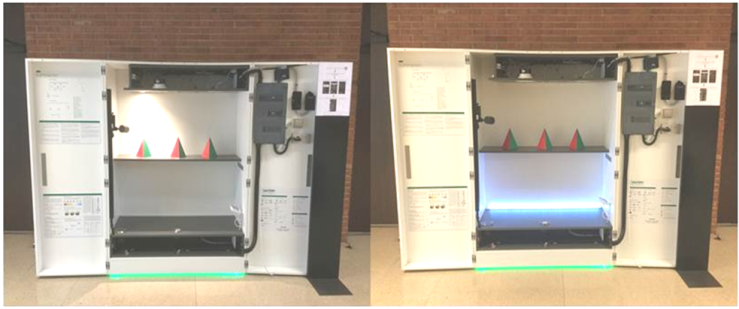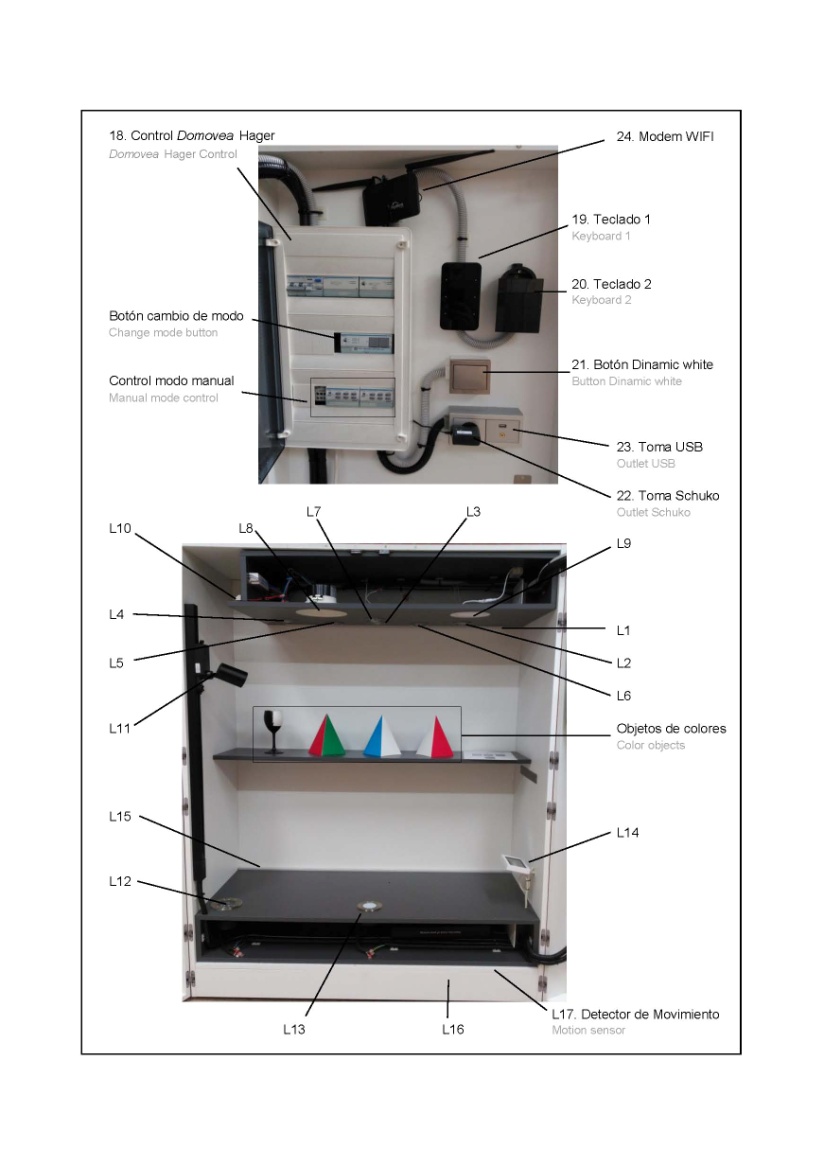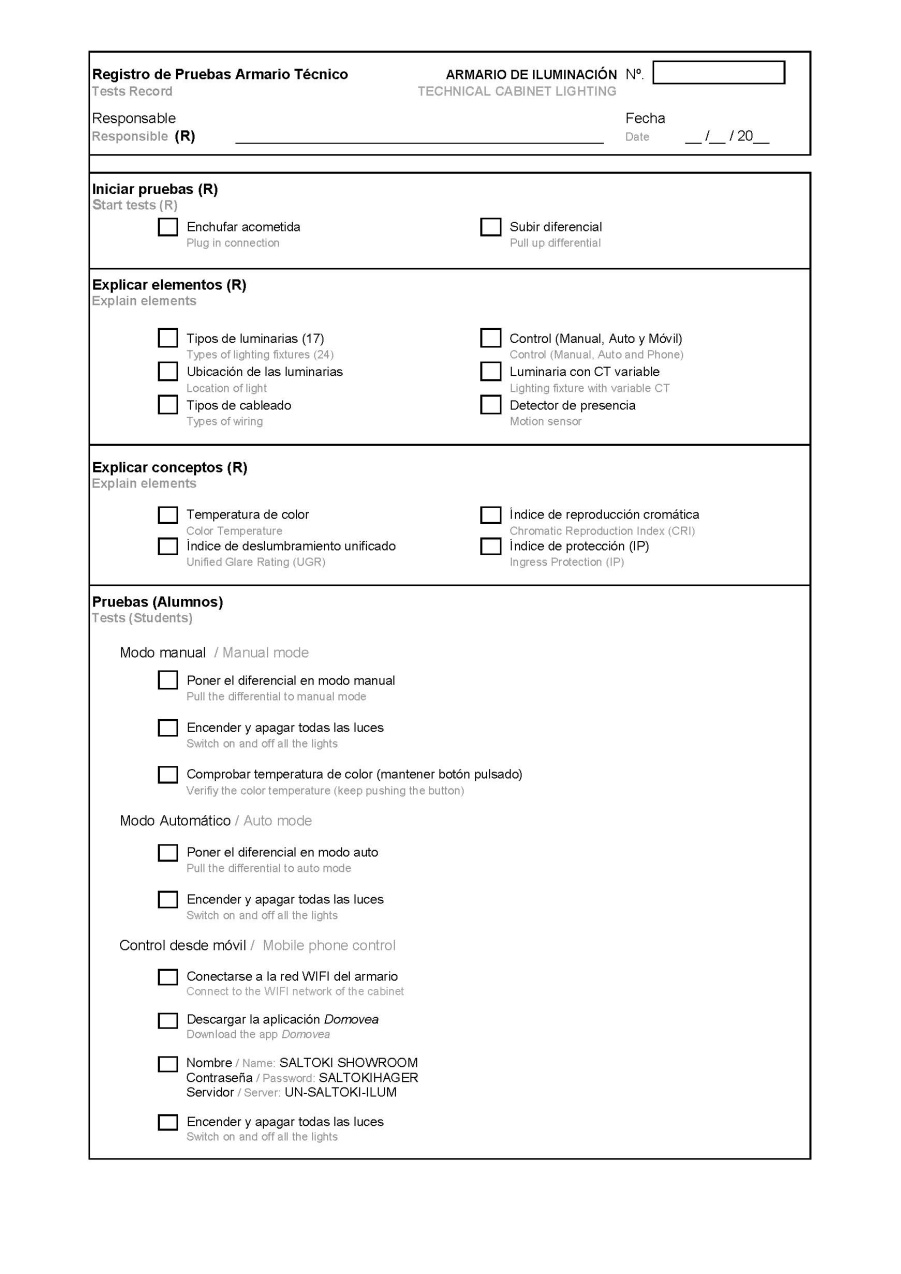-
Paper Information
- Paper Submission
-
Journal Information
- About This Journal
- Editorial Board
- Current Issue
- Archive
- Author Guidelines
- Contact Us
Architecture Research
p-ISSN: 2168-507X e-ISSN: 2168-5088
2019; 9(1): 1-6
doi:10.5923/j.arch.20190901.01

Lighting Portable Technical Cabinet as a Teaching Tool
César Martín-Gómez1, Elia Ibañez-Puy1, Amaia Zuazua-Ros1, Ignacio Gondán Jiménez2, Rubén Elizalde Amatriaian2, Asier Mateo3
1Universidad de Navarra, Department of Construction, Building Services and Structures, Campus Universitario, Pamplona, Spain
2Saltoki Suministros Eléctricos S.L. Pamplona. Departamento Ingeniería Eléctrica e Industrial Polígono, Pamplona, Spain
3Lighting Consultant, Calle Castelló 115, Madrid, Spain
Correspondence to: César Martín-Gómez, Universidad de Navarra, Department of Construction, Building Services and Structures, Campus Universitario, Pamplona, Spain.
| Email: |  |
Copyright © 2019 The Author(s). Published by Scientific & Academic Publishing.
This work is licensed under the Creative Commons Attribution International License (CC BY).
http://creativecommons.org/licenses/by/4.0/

This lighting cabinet was created with the main purpose of underlining the importance of the lighting learning for architecture students. It is a solution in-between the traditional showroom and the technical case, able to provide the aesthetical and technical values of architecture. Its multiple didactic possibilities, as well as, the little space required and economical investment turn it into a really interesting proposal. The cabinet, which can be considered as a mobile laboratory, needs minimum maintenance and can be easily stored. An operational control has been designed in order to ease the replication of this teaching experience in other Schools of Architecture or Engineering. Thanks to the cabinet design the students interact with real elements that allow the learning by touching. This way of teaching improves the quality of the learning process due to the fact that the students understand the concepts better, favouring the permanent and meaningful learning.
Keywords: Architecture, Lighting, Learning, Technical cabinet
Cite this paper: César Martín-Gómez, Elia Ibañez-Puy, Amaia Zuazua-Ros, Ignacio Gondán Jiménez, Rubén Elizalde Amatriaian, Asier Mateo, Lighting Portable Technical Cabinet as a Teaching Tool, Architecture Research, Vol. 9 No. 1, 2019, pp. 1-6. doi: 10.5923/j.arch.20190901.01.
Article Outline
1. Practical Application
- Applied learning of lighting concepts requires spaces of large dimensions, something not always possible even if 'touch' the light would be necessary. This tool allows to know different luminaires, their possibilities of placement, or concepts such as colour temperature, in a simple, cheap, replicable and modifiable way.
2. Introduction
- “The notion of physiological comfort (meaning responses to temperature and humidity but also to lighting and acoustics) has been a driving force in architectural production throughout the Twentieth Century. Whether concealed, embedded, exposed, or `featured´, building services environment has played a dominant role in the architectural design “[1].Since the early XXth century, the manufacturers of lighting equipment have been the ones to take the lead in having architects become familiar with the basic concepts in architectural lighting. In 1911, General Electrics inaugurated The Illuminating Engineering Laboratory of the General Electric Company, the first lighting laboratories in the USA dedicated to research, as well as, the training of architects. These laboratories were equipped with several scale models and samples of varied materials for the architects to experiment and visualize the extent to which the quality of the light affects their appearance and visibility [2].In Spain, the eight oldest Schools of Architecture include lighting in their plan of studies. The concern is spread throughout universities of all Europe [3, 4]. Architectural lighting knowledge acquisition is a common concerned in the teaching field [5] in order to ensure that future architects fulfill the lighting challenges that will face [6]. Several researches have proved that adequate demonstration aids and laboratory support are major factors in education quality and confirm academic value for students, making the subject more attractive”. These arguments have allowed that the project presented here was considered as a Teaching Innovation Project, in order to present it to the quality teaching procedures of the Spanish national administration.In spite of the unquestionable benefits for the students, the schools have serious difficulties in working with experimental rooms [7] due to a combination of economic reasons, spaces and equipment [8].A bibliographic search using the keywords lighting and teaching in Building Services Engineering Research and Technology has been made but any result has fulfilled both requirements. Several articles related with lighting [9-11] and with teaching [12, 13] have appeared in the searching, even one of them relates the effect of the lighting on students learning [14]. However, it has not been found the way of teaching lighting. This article introduces an innovate solution to teach lighting.The showrooms are great spaces to make lighting training lessons but require considerable spaces, an outstanding investment, frequent maintenance and the movement of the architects, who are receiving the training, to the location.The opposite solution is the technical case. It is a briefcase perfect for the material transport but with capacity limitation. Moreover, the didactic value is lower than the ones achieved in the showroom. Otherwise, its easy mobility and its low cost make it a considerable solution.The main objective of this article is to introduce an intermediate solution between the expensive showrooms and the limited technical case to teach lighting at architecture schools. The technical cabinet presented is an interesting format providing worthy didactical possibilities while requiring reduced space as well as a small investment.
 | Figure 1. Lighting technical cabinet with different lights on |
3. Background
- The educational field, from Primary School to University, is focused on improving the quality of the learning process. Researches try to fulfill this educational need from multiple points of views, such as, different styles of teaching and learning [15] different types of students [16] or active learning based on the role of the student [17]. The integral formation that characterizes the Spanish School of Architecture covers all the fields involve in the construction, including from the design theories to the technique areas [18] to new educational techniques [19].In this context, the School of Architecture has developed an outstanding labor in the last years in the building services teaching. This article is part of a continuous work based on the design and construction of several technical cabinets that improve the practical knowledge of the students. Each cabinet is focus on a different building service concept, such as electricity, emergency lighting, fire safety and heating/cooling [20]. Through laboratory activities the students are able to internalize the theoretical concepts and learn by touching. The lighting cabinet is part of this initiative and wants to bring closer the concepts of the architectural lighting, extending the previous experience with fire safety lighting [21].The main requirements were focused on the ability of the cabinet to fulfil not only the mobility requests but also support the intensive use by a high number of students. Therefore, it was built with solid and high durability materials, assuring both, a low cost of maintenance and a high reliability.All the elements of the equipment are easy to update. This characteristic implies that it can be used during more than one academic year, in fact it is being used during several courses, requiring a very low maintenance.Thanks to a smart system the cabinet can be controlled not only by the keyboards and button, but also wireless. The system is provided with a closed and autonomous WIFI network that able to control the lights using any tablet or smartphone with the application Domovea ®.The previous experiences in the development of this kind of educational technical cabinets have been used as a reference, in order to make contact easily with the manufacturer of the cabinet.
 | Figure 2. The five technical cabinets stored: electricity, HVAC, lighting (marked), fire safety and emergency lighting |
4. Components and Concepts Description
- This section includes the characteristics of the different elements and the main lighting concepts that define them. The information of the different elements has been gathered from the catalogues of the manufacturers. The components of the cabinet are the following:
 | Figure 3. Elements of the lighting technical cabinet |
4.1. Lights
- Superior Tray:1. L1. LED CELER tape light Dinamic White. Consist on a Larko profile of Klus and 2 LED CELER tape light 24w/m 24v DC, 2500-3000 lm/m, in warm (3000K) and cold (5500K) color temperature. Power supply CELER LPV 230/24v type 2 IP67. It shows the performance of a “Dinamic white” system. It is activated pushing button 21. 2. L2. Downlight with lamp GU10 LED CELER 5000K 6,5w. 3. L3. Downlight with lamp GU10 LED CELER 4000K 6,5w. 4. L4. Downlight with lamp GU10 LED CELER 3000K 6,5w. 5. L5. Downlight with lamp GU10 LED CELER optical Spot. 6. L6. Downlight with lamp GU10 LED CELER optical Flood. (5x) Downlight with lamp GU10 Spotled de CELER 6,5w, 230v AC, 600-630 lm, CRI>80, in beam angles 40° y 60° and warm (3000K), neutral (4000K) and cold (5500K) color temperatures. All of them are installed in Spot Celer Downlight fixtures.7. L7. Downlight with lamp GU10 LED CELER 5w. 230v, 450 lm, CRI<70 and beam angle of 40°. 8. L8. Downlight LED Philips DN125B LED10S/840 de 15w, 230v, 1000 lm CRI>80, neutral color temperature (4000k) y UGR<19.9. L9. Downlight LED Panel CELER 9w, 230v, 830lm. CRI>80, neutral color temperature (4000K) and UGR>21.10. L10. LED CELER tape light 24w/m, 24v, 2700 lm/m, neutral white (4000K), installed in an angular profile CELER for cove lighting.11. L11. Track head LEDECO LED track CELER 15w, 230v, 900 lm, warm color temperature (3000K) and the corresponding three-phase track with accessories. It is a typology commonly used in the Retail sector.Lower Tray:12. L12. Recessed uplight 5540 LED 5w, 230v, warm color temperature (3000K), IP65 y spot optic. Uplight wallwasher for facades. 13. L13. Recessed uplight 7320 LED 3w, 230v, warm color temperature (3000K), IP65 Flood optic. Diffuses the light instead of projecting it. 14. L14. Projector Slim LED CELER 10w, 230v, 750 lm, CRI>80, IP65 y warm color temperature color (3000K). It is an exterior projector for wallwasher facade. 15. L15. LED tape light CELER RGB.16. L16. LED RGB tape light CELER 14,4 w/m 24v DC. Toe Kick Lighting.17. L17 High frequency motion sensor hidden. It is installed in the false floorand actives type L16 fixture. This technology is able to pass through materials and detect the movement trough the wood.The lower tray is intended to exterior lighting fixtures with high IP.
4.2. Control System
- 18. Control Domovea Hager: Electric panel that allows to change the control mode. 19. Keyboard B.IQ Berker Hager: group of switches. 20. Keyboard B.IQ Berker Hager Clime: group of switches. 21. Wall box switch K5 Berker Hager: Button dynamic white that allows to change the CT.22. Outlet Schuko K Berker Hager: Additional supply connection.23. Outlet USB K Berker Hager: Allows a USB connection.24. Modem WIFI: Supply the cabinet of an autonomous and closed WIFI network.
4.3. Concepts
- Several concepts of the lighting field, such as Color Temperature (CT), Color Rendering Index (CRI), Unified Glare Rating (UGR) and Ingress Protection (IP) are explained during the test using different types of lights, at the same time that the students observe in situ its effects. It is called Color Temperature to the temperature of an ideal black-body radiator that radiates light of a color comparable to the light of the source. It is conventionally expressed in Kelvin (°K). CT over 5000°K are called “cool colors” (bluish white) and lower color temperature (27000-3000°K) are called “warm colors” (yellowish white through red). L1 to L6 permit to observe different CT. The Color Rendering Index measures the ability of the light source to reveal the colors of various objects faithfully in comparison with and ideal light source and it is determined by the light source spectrum. The highest possible value of CRI is 100. L7 and L8 allow to observe the effect of different CRI. L7 is the lamp with low quality since it has a lower CRI. Unified Glare Rating measures the glare in a given environment. Considering that glare is defined as visual conditions in which there is excessive contrast or an inappropriate distribution of light sources that disturbs the observer or limits the ability to distinguish details and objects. L8 and L9 able the students to observe the effect in the light of different UGR. The Ingress Protection classifies and rates the degree of protection provide against intrusion, dust, accidental contact, and water by mechanical casings and electrical enclosures. The first digit indicates the level of protection of solid particle and the second one of liquid particle. The IP is included in the exterior lamps 8L12, L13, L14) since they support tougher conditions.
5. Tests
- An operational protocol has been written in order to easy the use of the technical cabinet. Besides, English translation is included to increase the number of possible final users. To ensure the learning by touching experience the groups are of less than eight people, hence, everyone can practice following the guidelines of the protocol. Each time, before testing, the different components of the cabinets are explained. The different types of lighting fixture solutions, the position, the types of wires and the different lighting concepts must be explained. The tests are designed for students in order to understand the influence of different types of lighting and control systems.
5.1. Test 1 Manual Mode
- Pull the differential in the manual mode. 1.1. The Dynamic White system (L1) is activated pushing button 21. Verify that by short taps the ON-OFF function is activated and by keeping the button pushed verify the changes in the color temperature.1.2. Switch on and off all the lights using the manual mode by pushing the different buttons.
 | Figure 4. Protocol for the lighting cabinet (I) |
5.2. Test 2 Auto Mode
- Pull the differential in auto mode. 2.1. L2, L3 and L4 are activated by the keyboard 19. It is possible to distinguish the three color temperature 5000K, 4000K and 3000K. Use the pyramids with different colors in the faces in order to observe how the perception of the color varies depending on the color temperature.2.2. L5 and L6 differ in the open beam angle and are activated by the keyboard 19. It has to be observed how the L5 is a spot, light with centered beam, while the L6 is a flood, with an opened beam. 2.3. The L7 is activated with the keyboard 20. Alternate the L7 and L3 in order to observe how the vision of the same object changes depending on the CRI.2.4. The downlight lights (L8 and L9), activated by the keyboard 19, differ in the UGR values depending on its construction. Verify that the L8 (UGR>19) gives a higher visual comfort than the L9 (UGR>21). 2.5. Using the keyboard 20 switch on and off the rest of the lights, proving the difference between the L12, L13 and L14.
5.3. Test 3 Mobile Application
- The cabinet has an autonomous WIFI due to the modem installed. This network allows the students to connect the mobile phones to the cabinet and manage the different lights. This test is based on giving the student the responsibility of control the LED RGB by the app sliding the finger to choose their color and the intensity.
 | Figure 5. Screenshot of the application |
5.4. Test 4 Motion Sensor
- Under the inferior tray there is a hidden motion sensor connected to a green LED that switches on when the sensor detects changes of movement. Verify the functioning of the sensor by doing different moves observing the response.
6. Conclusions
- This article presents a technical cabinet as an appealing teaching tool to improve the learning by touching of lighting knowledge of the students of architecture. This cabinet can be easily replicate and provides worthy didactical possibilities while requiring reduced space as well as a small investment.Several aspects have been improved comparing with the previous cabinets. In this lighting cabinet must be outlined the simplicity of use. Only by following the protocol and pushing several buttons anyone is able to connect it and observed its performance. The implication of the students and its interaction with the system has improved too. The students can control the lighting fixtures with their mobile phones, boosting the learning by touching and making the lessons more attractive. Other conclusion drawn from the design and operation of the cabinet is that this teaching system provides new learning dynamics for students and has made the subject more attractive at first hand. The interest, shown by students, has confirmed the academic value not only for Architecture but also for the Design degree, allowing that more than 100 students learn each course the lighting concepts with the use of this cabinet (40% Design Degree / 60% Architecture Degree).Only a few references related with lighting learning experiences similar to the cabinet have been found. This fact also supports the academic value of this teaching initiative as a promising teaching tool.Besides, the design and construction of the project has improved the collaboration between the university and the company. The company, who has executed the cabinet, showed a huge interest not only due to the publicity received but also for the great chances of developing a new product that did not exist in the market. This cooperative work brings benefits for both parts.
 Abstract
Abstract Reference
Reference Full-Text PDF
Full-Text PDF Full-text HTML
Full-text HTML